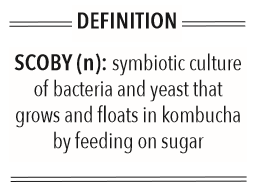The art of creating kombucha leather
Science inspires sustainable fashion with new eco-friendly material
October 18, 2018
Fueled by our consumerism, climate change continues to wreak havoc. The demand for crude oil and the mountains of plastic in our oceans often take the forefront in discussions about the negative human impact on the planet. What is equally as formidable, however, is the insatiable demand for animal furs and skins in fashion. In the path of these horsemen of the apocalypse floats a three-inch thick, white agar-like disk of live bacteria and culture, quietly growing in a tub of sugary black tea.
As climate change becomes a more central issue, clothing designers have looked to alternative methods of production and less conventional materials to cut down on their footprint.
One material in particular has not only been questioned in terms of environmental impact, but also in terms of animal cruelty. Leather, durable and ubiquitous, has been used for over 7,000 years across the world, tanned using natural resources. When sustainably practiced, and all parts of the animal are respectfully utilized, leather and cows, the main source, raises no concern.
However, today, the highest quality leather has no imperfections, and often, skin from livestock used for food is not adequate. Additionally, fueled by the meat industry, cows are raised in alarming populations, increasing methane levels unnaturally and exhausting water and land resources.
Leather is also often now tanned and dyed using synthetic chemicals that not only harm the workers but also the environment. Chrome, a known carcinogen, and other heavy oils are used in the production process.
In light of negative impacts, more and more companies are focusing on using more eco-friendly processes. Take Future of Retro, for example. Based in Norman, Oklahoma, the small company focuses on the art of leather jackets and openly reports to customers on the origin of their materials and steps in their process. Just recently, the team has started to look into faux leather.
“For us, it is important to follow the direction of the culture as well as what the customer is wanting. We care very much about the environment which makes it an important factor for us,” Future of Retro’s group of designers and manufacturers said in an interview over email.
The most common alternative to real leather, polyurethane, is less harmful in terms of environmental impacts. Though it is less harmful in terms of environmental impacts, polyurethane continues to use fossil fuels, a nonrenewable resource. Another part of the struggle to find a leather alternative is the experience.
“The drawback is that as an artist, they do not yield nearly the same result of what real leather does,” Future of Retro said.
Enter kombucha, a fermented drink made using a bacteria and yeast culture and some black or green tea. Out of a myriad nature-based options, including tree bark and kelp, kombucha is perhaps a most unexpected place to look. When other plant options reliably create pulp or fibrous fabric-like material, a colony of bacteria seems less likely to yield a leather-like product.
The slimy layer of bacteria and beards of yeast are usually seen as a side product of kombucha production. When satisfying the demand caused by tech companies and health enthusiasts, much of the SCOBY (Symbiotic Culture Of Bacteria and Yeast), or what is used to make kombucha leather, is either discarded or reused for another batch of the tea. Creating kombucha leather reverses this relationship and nearly eliminates the water usage dilemma in leather production, as its side product is in high demand as a drink.
Within a week and a half, a gallon of tea yields a paper-thin but durable sheet of healthy bacteria when dried, with no harmful effects. In two weeks, the film thickens considerably. In comparison with the large-scale resource usage of raising cows or creating polyurethane, the costs are relatively low, and the time window for a sheet of kombucha leather needed to create a small pouch is much shorter than other options.
When oiled and folded, the kombucha acts like a cloth, and when the paper-thin sample is folded four times, the result is a viable leather alternative, both in terms of looks and texture. From personal experience, kombucha is also low maintenance and easy to grow. With professional tools and controls, a higher quality leather can be produced with ease.
Perhaps in the search for more sustainable fashion, the answer lies not in the world of larger farms and heightened production, but in places often overlooked as waste or side products. As the SCOBY quietly grows in the tub, the sustainable fashion movement it represents continues to spread in the most unexpected ways.
This piece was originally published in the pages of The Winged Post on Oct. 17, 2018.


















![“[Building nerf blasters] became this outlet of creativity for me that hasn't been matched by anything else. The process [of] making a build complete to your desire is such a painstakingly difficult process, but I've had to learn from [the skills needed from] soldering to proper painting. There's so many different options for everything, if you think about it, it exists. The best part is [that] if it doesn't exist, you can build it yourself," Ishaan Parate said.](https://harkeraquila.com/wp-content/uploads/2022/08/DSC_8149-900x604.jpg)




![“When I came into high school, I was ready to be a follower. But DECA was a game changer for me. It helped me overcome my fear of public speaking, and it's played such a major role in who I've become today. To be able to successfully lead a chapter of 150 students, an officer team and be one of the upperclassmen I once really admired is something I'm [really] proud of,” Anvitha Tummala ('21) said.](https://harkeraquila.com/wp-content/uploads/2021/07/Screen-Shot-2021-07-25-at-9.50.05-AM-900x594.png)







![“I think getting up in the morning and having a sense of purpose [is exciting]. I think without a certain amount of drive, life is kind of obsolete and mundane, and I think having that every single day is what makes each day unique and kind of makes life exciting,” Neymika Jain (12) said.](https://harkeraquila.com/wp-content/uploads/2017/06/Screen-Shot-2017-06-03-at-4.54.16-PM.png)








![“My slogan is ‘slow feet, don’t eat, and I’m hungry.’ You need to run fast to get where you are–you aren't going to get those championships if you aren't fast,” Angel Cervantes (12) said. “I want to do well in school on my tests and in track and win championships for my team. I live by that, [and] I can do that anywhere: in the classroom or on the field.”](https://harkeraquila.com/wp-content/uploads/2018/06/DSC5146-900x601.jpg)
![“[Volleyball has] taught me how to fall correctly, and another thing it taught is that you don’t have to be the best at something to be good at it. If you just hit the ball in a smart way, then it still scores points and you’re good at it. You could be a background player and still make a much bigger impact on the team than you would think,” Anya Gert (’20) said.](https://harkeraquila.com/wp-content/uploads/2020/06/AnnaGert_JinTuan_HoHPhotoEdited-600x900.jpeg)

![“I'm not nearly there yet, but [my confidence has] definitely been getting better since I was pretty shy and timid coming into Harker my freshman year. I know that there's a lot of people that are really confident in what they do, and I really admire them. Everyone's so driven and that has really pushed me to kind of try to find my own place in high school and be more confident,” Alyssa Huang (’20) said.](https://harkeraquila.com/wp-content/uploads/2020/06/AlyssaHuang_EmilyChen_HoHPhoto-900x749.jpeg)












